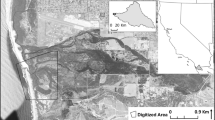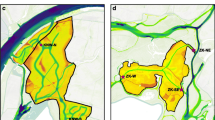Abstract
Over the last one hundred years, compartmentalization and water management activities have reduced water flow to the ridge and slough landscape of the Everglades. As a result, the once corrugated landscape has become topographically and vegetationally uniform. The focus of this study was to quantify variation in surface flow in the ridge and slough landscape and to relate flow conditions to particulate transport and deposition. Over the 2002–2003 and 2003–2004 wet seasons, surface velocities and particulate accumulation were measured in upper Shark River Slough in Everglades National Park. Landscape characteristics such as elevation, plant density and biomass also were examined to determine their impact on flow characteristics and material transport. The results of this study demonstrate that the release of water during the wet season not only increases water levels, but also increased flow speeds and particulate transport and availability. Further, flow speeds were positively and significantly correlated with water level thereby enhancing particulate transport in sloughs relative to ridges especially during peak flow periods. Our results also indicate that the distribution of biomass in the water column, including floating plants and periphyton, affects velocity magnitude and shape of vertical profiles, especially in the sloughs where Utricularia spp. and periphyton mats are more abundant. Plot clearing experiments suggest that the presence of surface periphyton and Utricularia exert greater control over flow characteristics than the identity (i.e., sawgrass or spike rush) or density of emergent macrophytes, two parameters frequently incorporated into models describing flow through vegetated canopies. Based on these results, we suggest that future modeling efforts must take the presence of floating biomass, such as Utricularia, and presence of periphyton into consideration when describing particulate transport.
Similar content being viewed by others
References
Bazante, J. H. M., H. Solo-Gabriele, M. Ross, D. Childers, S. Mitchell-Bruker & L. Leonard, 2003. Water velocity and suspended solids concentrations in the proximity of tree islands in Everglades National Park. Proceedings of the Joint Conference on the Science and Restoration of the Greater Everglades and Florida Bay Ecosystem, “From Kissimmee to the Keys”. April 13–18, 2003. Palm Harbor, Florida, 19–20.
Childers, D. L., J. N. Boyer, S. E. Davis III, C. J. Madden, D. T. Rudnick & F. H. Sklar, 2005. Relating precipitation and water management to nutrient concentration patterns in the oligotrophic “upside down” estuaries of the Florida Everglades. Limnology and Oceanography 51(1, part2): 602-616.
M. J. Chimney G. Goforth (2001) ArticleTitleEnvironmental impacts to the Everglades ecosystem: a historical perspective and restoration strategies Water Science and Technology 44 93–100 Occurrence Handle11804164 Occurrence Handle1:CAS:528:DC%2BD38XhtVykt7Y%3D
T. Christiansen P. L. Wiberg T. G. Milligan (2000) ArticleTitleFlow and sediment transport on a tidal salt marsh surface Estuarine, Coastal and Shelf Science 50 315–331 Occurrence Handle10.1006/ecss.2000.0548
J. W. Harvey J. E. Saiers J. T. Newlin (2005) ArticleTitleSolute transport and storage mechanisms in wetlands of the Everglades, south Florida Water Resources Research 41 1–14 Occurrence Handle10.1029/2004WR003507 Occurrence Handle1:CAS:528:DC%2BD2MXmsVGmtrY%3D
R. S. Jadhav S. G. Buchberger (1995) ArticleTitleEffects of vegetation on flow through free water surface wetlands Ecological Engineering 5 481–496 Occurrence Handle10.1016/0925-8574(95)00039-9
P. K. Kundu (1990) Fluid Mechanics Academic Press San Diego
J. A. Kushlan (1993) Freshwater wetlands M. S. Dennison J. F. Berry (Eds) Wetlands: Guide to Science, Law, and Technology Noyes Publications Park Ridge, NJ 74–127
J. K. Lee L. C. Roig H. L. Jenter H. M. Visser (2004) ArticleTitleDrag coefficients for modeling flow through emergent vegetation in the Florida Everglades Ecological Engineering 22 237–248 Occurrence Handle10.1016/j.ecoleng.2004.05.001
L. A. Leonard (1997) ArticleTitleControls of sediment transport and deposition in an incised mainland marsh basin, southeastern North Carolina Wetlands 17 263–274 Occurrence Handle10.1007/BF03161414
L. A. Leonard A. C. Hine M. E. Luther (1995) ArticleTitleSurficial sediment transport and deposition processes in a Juncus roemerianus marsh, West-central Florida Journal of Coastal Research 11 322–336
L. A. Leonard M. E. Luther (1995) ArticleTitleFlow hydrodynamics in tidal marsh canopies Limnology and Oceanography 40 1474–1484 Occurrence Handle10.4319/lo.1995.40.8.1474
L. A. Leonard D. J. Reed (2002) ArticleTitleHydrodynamics and sediment transport through tidal marsh canopies Journal of Coastal Research SI 36 459–469
S.S Light J. W. Dineen (1994) Water control in the Everglades: A historical perspective S. M. Davis J. C. Ogden (Eds) Everglades: The Ecosysten and its Restoration St Lucie Press Delray Beach, FL 47–84
C. M. Loveless (1959) ArticleTitleA study of the vegetation in the Florida Everglades Ecology 40 1–9 Occurrence Handle10.2307/1929916
S. Mitchell-Bruker J. Bazante D. Childers L. Leonard M. Ross H. Solo-Gabriele R. Snow S. Stothoff (2005) Effect of Hydrology on Everglades Ridge and Slough Community Report to Everglades National Park Homestead, FL
H. M. Nepf (1999) ArticleTitleDrag, turbulence, and diffusion in flow through emergent vegetation Water Resources Research 35 479–489 Occurrence Handle10.1029/1998WR900069
H. M. Nepf J. A. Sullivan R. A. Zavistoski (1997) ArticleTitleA model for diffusion within emergent vegetation Limnology and Oceanography 42 1735–1745
U. Neumeier P. Ciavola (2004) ArticleTitleFlow resistance and associated sedimentary processes in a Spartina maritima salt marsh Journal of Coastal Research 20 435–447 Occurrence Handle10.2112/1551-5036(2004)020[0435:FRAASP]2.0.CO;2
J. E. Saiers J. W. Harvey S. E. Mylon (2003) ArticleTitleSurface-water transport of suspended matter through wetland vegetation of the Florida Everglades Geophysical Research Letters 30 IssueID19 1–5 Occurrence Handle10.1029/2003GL018132
Science Coordination Team (SCT), 2003. The Role of Flow in the Everglades Ridge and Slough Landscape. South Florida Ecosystem Restoration Working Group. Approved by the SCT: January 14, 2003.
M. L. Shelton (1990) ArticleTitleSurface-water flow to Everglades National Park Geographical Review 80 355–369 Occurrence Handle10.2307/215846
Z. Shi J. S. Pethick K. Pye (1995) ArticleTitleFlow structure in and above the various heights of a saltmarsh canopy: a laboratory flume study Journal of Coastal Research 11 1204–1209
D. A. Stern R. Khanbilvardi J. C. Alair W. Richardson (2001) ArticleTitleDescription of flow through a natural wetland using dye tracer tests Ecological Engineering 18 173–184 Occurrence Handle10.1016/S0925-8574(01)00076-3
R. P. Stumpf (1983) ArticleTitleThe process of sedimentation on the surface of a salt marsh Estuarine, Coastal and Shelf Science 17 495–508 Occurrence Handle10.1016/0272-7714(83)90002-1
D. Tabb (1990) Hydroperiod Conditions of Key Environmental Indicators of Everglades National Park and Adjacent East Everglades Area as Guide to Selection of an Optimum Water Plan for Everglades National Park, Florida Tropical BioIndustries, Inc. Miami
J. E. Vermaat L. Santamaria P. J. Roos (2000) ArticleTitleWater flow across and sediment trapping by submerged macrophyte beds of contrasting growth form Archiv für Hydrobiologie 148 549–562 Occurrence Handle1:CAS:528:DC%2BD3cXlvVemsLY%3D
Wood, A., 2005. Dynamics of detrital particulate organic material in the ridge and slough landscape of the Everglades. Masters Thesis, Florida International University.
F. C. Wu H. W. Shen Y. J. Chou (1999) ArticleTitleVariation of roughness for unsubmerged and submerged vegetation Journal of Hydraulic Engineering 125 934–942 Occurrence Handle10.1061/(ASCE)0733-9429(1999)125:9(934)
Author information
Authors and Affiliations
Corresponding author
Rights and permissions
About this article
Cite this article
Leonard, L., Croft, A., Childers, D. et al. Characteristics of surface-water flows in the ridge and slough landscape of Everglades National Park: implications for particulate transport. Hydrobiologia 569, 5–22 (2006). https://doi.org/10.1007/s10750-006-0119-y
Issue Date:
DOI: https://doi.org/10.1007/s10750-006-0119-y




